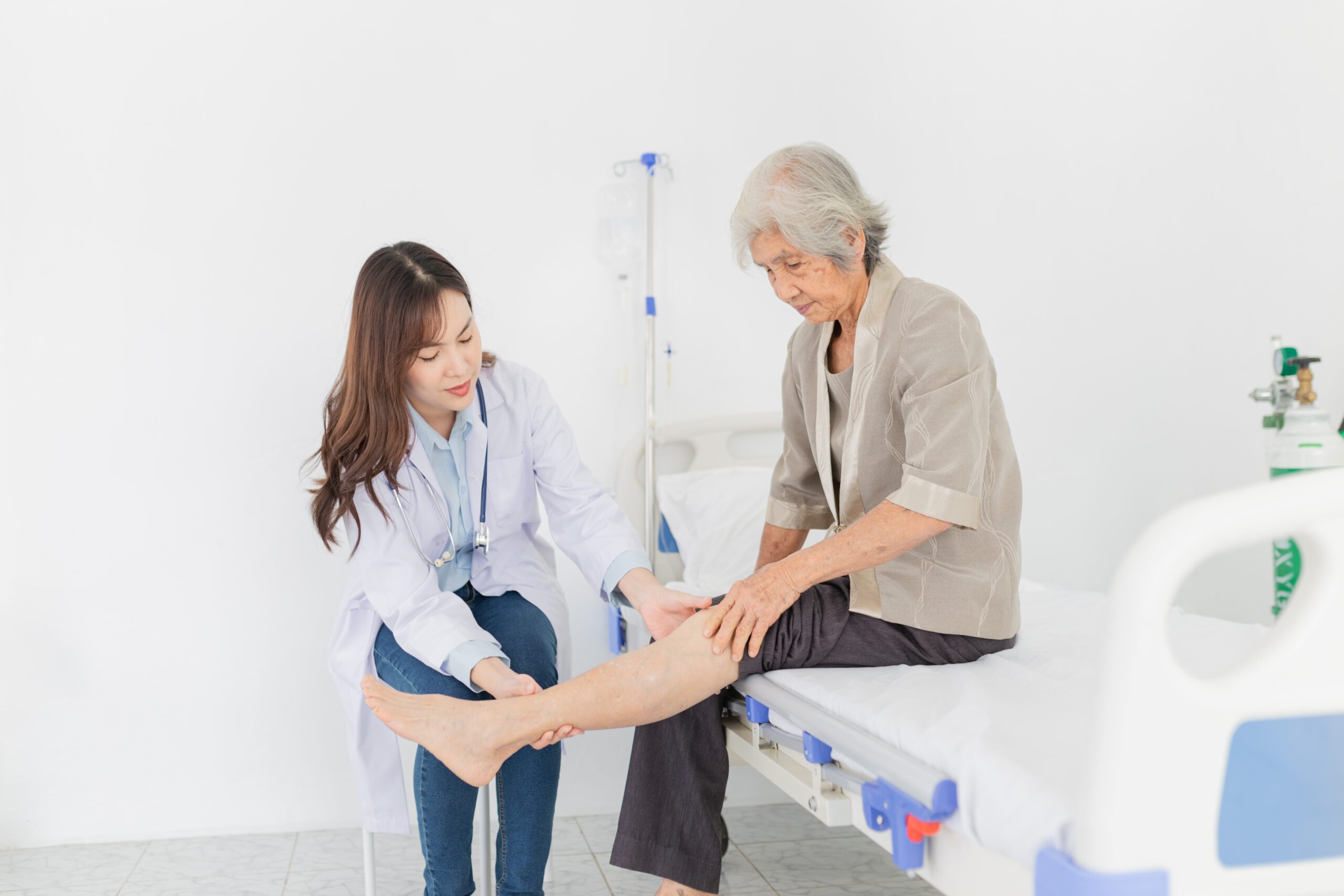Lower Extremity Edema
Lower Extremity Edema
Learn how you can benefit from advanced, comprehensive treatment for lower extremity edema at Innovative Wound Care Specialists.
Lower extremity edema mainly happens from blood vessels leaking fluid, and/or too much fluid buildup, which causes excess swelling. This mainly occurs in the lower half of the body such as hips, thighs, knee, leg, ankle, and foot.
Anyone can suffer from lower extremity edema, however individuals who are pregnant or over the age of 65 may experience different cases of lower extremity edema. One main cause of lower extremity edema in individuals over 65 is from Chronic Venous Insufficiency in which veins in the lower extremities are not functioning properly leading to excess fluid build up leading to swelling and other skin concerns like ulcers.
Pregnant women are at a greater chance of facing lower extremity edema, especially during later terms of pregnancy, simply from excess fluids in the body. This swelling is not only limited to lower extremities, but also the face and hands. However, any form of lower extremity edema in pregnant women should go away after delivery.
Start Treatment Today
There are mild and severe causes of lower extremity edema.
Causes of lower extremity edema include:
- High intake of salty foods, such as processed meats, fast foods, or frozen meals.
- Pregnancy creates hormone changes, pressure from the uterus, and fluid retention which can result in swelling of the lower extremities.
- Premenstrual creates hormonal fluctuations in the body with increased blood flow leading to lower extremity edema.
- Sitting or standing for too long leads to inactivity of the muscle and poor circulation creating swelling in the legs, feet, or ankles.
- Certain medications for blood pressure, heart conditions, mental conditions, and hormone conditions can impact circulation and swelling.
- Deep vein thrombosis, also known as DVT, can lead to prolonged immobility which can result in blood clotting and swelling if not monitored.
- Congestive heart failure impacts fluid retention, blood pressure, and a reduction in circulation all impacting swelling of the lower extremities.
- Kidney disease, or damage, can lead to protein loss, fluid retention, and electrolyte imbalance all impacting lower extremity edema.
- Liver damage can result in hypoalbuminemia where fluid leaks to the surrounding tissue leading to swelling.
Lower extremity edema can cause complications which include:
Painful swelling
- Difficulty walking
Skin ulcer(s)
- Stifiness
- Itching from stretched skin
- Decreased blood flow
If lower extremity edema is severe enough to cause the complications as described above, it is crucial for the individual to seek medical treatment, to prevent further complications. Some additional signs to look for when experiencing lower extremity edema include:
- Pain or discomfort of the affected extremity
- Open wound on affected extremity
- Shortness of breath
- Trouble walking

Treatment of mild lower extremity edema can be accomplished by elevating the leg, ankle, or foot for 30 minutes throughout the day. This can help to promote blood circulation and decrease swelling.
However, more severe cases of lower extremity edema require further attention with a skilled medical provider.
One common treatment for lower extremity edema is the use of a compression dressing. This serves as a wrap for the affected extremity to reduce swelling, and even promote healing if an ulcer is presented on the swollen area.
Your provider will be able to determine which form of compression is needed and the level of tightness needed to promote optimal healing for the affected area.
Each lower extremity edema case is different as underlying medical conditions can cause swelling of the lower extremities. Again, your medical provider will be able to assess your condition and create an appropriate treatment plan.
Some treatment plans your medical provider may provide you with for prevent of lower extremity edema can be:
- Lifestyle change, such a diet or exercise change
- Low salt intake
- Use of compression socks
When a provider determines that a compression dressing will be beneficial for a lower extremity edema case, the length of how long the dressing should be on will be determined by the provider. It is important to follow their guidelines as this will help to promote healing, reduction of swelling, and a decrease of infection if a wound is presented.
During the time you have a compression dressing for lower extremity edema, it is important to ensure that the dressing stays dry at all times. When showering, you may cover the compression in a garbage bag or cast cover. Keeping a compression dressing on a lower extremity edema dry is crucial to prevent infection or delay to the healing process.
Chronic wounds can cause patients to suffer and affect mobility. While most wounds heal quickly, chronic ulcers may not heal or fail to improve for weeks and can cause severe problems if left untreated.
Wound Care May Include . . .
- Compression Dressings & Advanced Wound Dressings – We offer a variety of innovative wound dressings, including those with antimicrobial properties, moisture control, and pressure relief features.
- Laboratory and Vascular Evaluation – Monitor patient’s peripheral artery disease (PAD) and its effect on supplying blood to wounded tissues.
- Cellular or Tissue-Based Products – Utilizing bioengineered skin grafts and substitutes to promote faster healing and tissue regeneration.
- Wound Measurement and Photographs – To monitor wound progression and wound healing.
- Hyperbaric Oxygen Therapy (HBOT) – Enhancing oxygen supply to the affected area to accelerate wound healing and combat infection.
- Surgical Procedures and Support – Assisting in wound closure, infection control, tissue removal or repair, promotion of granulation tissue, reducing tension on wounds, enhancing blood supply, and management of complications.
- Negative Pressure Wound Therapy (NPWT) – Using controlled suction to remove exudate, reduce edema, and improve blood flow to the wound.
- Prosthetic and Pressure Relief Assistance – To reduce pressure on the ulcer, we provide specialized footwear and custom orthotics, designed to redistribute weight and minimize friction.
- Debridement – Removal of dead, damaged, or infected tissue by surgical or other means to improve the healing potential of the remaining healthy tissue.
If you are suffering from lower extremity edema, and looking for relief or management, our team of professional wound specialists at Innovative Wound Care Specialists are ready to provide you with the care you deserve. You can connect with us online to request an appointment, and one of our skilled team members will be in touch with you.
